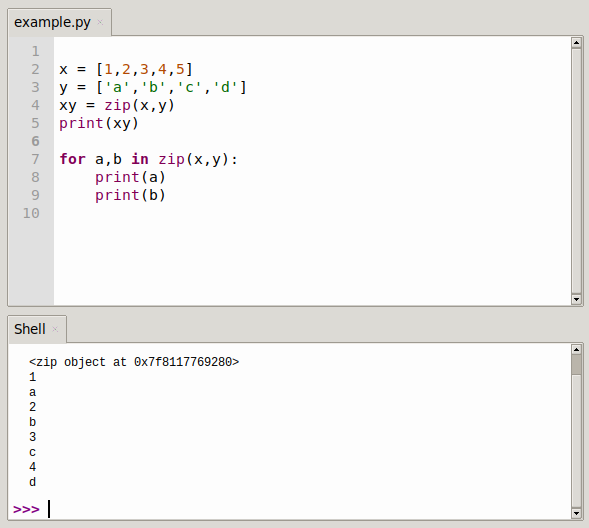Python zip() Function
The zip() function accepts a series of iteratable objects as arguments, packages the corresponding elements of different objects into a tuple, and returns a list consisting of these tuples.
If the length of the incoming argument is not equal, then the list returned is the same length as the shortest object in the incoming argument.
Related course: Complete Python Programming Course & Exercises
Syntax
zip([iterable, ...])
Basic understanding of Python zip() function
If you have two lists, you can zip() them like zip(x,y):
x = [1,2,3,4,5]
y = ['a','b','c','d']
xy = zip(x,y)
print xy
for a,b in zip(x,y):
print(a)
print(b)
Results in:
[(1, 'a'), (2, 'b'), (3, 'c'), (4, 'd')]
1
a
2
b
3
c
4
d

Example 2 So what if you only have one argument in zip() ? The program below shows.
x = [1,2,3,4,5]
xx = zip(x)
print(xx)
for a in zip(x):
print(a)
for a in zip(x):
print(a[0])
Outputs:
[(1,), (2,), (3,), (4,), (5,)]
(1,)
(2,)
(3,)
(4,)
(5,)
1
2
3
4
5
Example 3 Here's another example of the zip function, this time with a dynamic size parameters.
x = [[1,2,3,4],['a','b','c'],[7,8,9]]
y = zip(*x)
print(y)
for a in y:
print(a)
for a,b,c in zip(*x):
print(a)
print(b)
print(c)
This outputs:
[(1, 'a', 7), (2, 'b', 8), (3, 'c', 9)]
(1, 'a', 7)
(2, 'b', 8)
(3, 'c', 9)
1
a
7
2
b
8
3
c
9
Another zip() example Just for understanding, here is another example of the zip function.
>>> a = [1,2,3]
>>> b = [4,5,6]
>>> c = [4,5,6,7,8]
>>> zipped = zip(a,b) # Packaged list of tuple
[(1, 4), (2, 5), (3, 6)]
>>> zip(a,c) # The number of elements matches the shortest list
[(1, 4), (2, 5), (3, 6)]
>>> zip(*zipped) # In contrast to zip, which can be understood as decompression, the inverse process of zip can be used to transpose the matrix
[(1, 2, 3), (4, 5, 6)]